VNDLS
Work in progress. Preview acess only for participating members
The work presented herein has been guided and inspired by Faizan Khatri,
who has been intensively involved with Street Animal Research and Design Exploration called The Initiative. His work includes Studies, mappings, photographic, video-graphic and illustrative documentations knitted over years of understanding and research.
Faizan is an architect and educator. He is one of the three partners at studio eight twentythree, a collaborative design practice based in Mumbai, India. His constant efforts and humble nature have, over the years, inspired several of his students, colleagues and employees to join in his endeavors towards bettering the lives of the street animals.
who has been intensively involved with Street Animal Research and Design Exploration called The Initiative. His work includes Studies, mappings, photographic, video-graphic and illustrative documentations knitted over years of understanding and research.
Faizan is an architect and educator. He is one of the three partners at studio eight twentythree, a collaborative design practice based in Mumbai, India. His constant efforts and humble nature have, over the years, inspired several of his students, colleagues and employees to join in his endeavors towards bettering the lives of the street animals.
He has actively shared his resources and expertise to guide, design, document and help build the Animal Shelter Pods along with a fast-growing team of enthusiastic individuals who believe in this vision through VNDLS.
You can delve deeper into his work here:
https://www.theinitiative.life/
We would also like to extend our gratitude towards all architects, artitsts and animal enthusiats that participated with us. To name a few Yash Pendse, Sneha Desai, Advaiata Kelkar, Nayan Mote, Shashank Ahuja, Devarsh Seth, Dhruv Chavan, Surya Subramaniam, Varun Mehta
You can delve deeper into his work here:
https://www.theinitiative.life/
We would also like to extend our gratitude towards all architects, artitsts and animal enthusiats that participated with us. To name a few Yash Pendse, Sneha Desai, Advaiata Kelkar, Nayan Mote, Shashank Ahuja, Devarsh Seth, Dhruv Chavan, Surya Subramaniam, Varun Mehta
-------------------------------------
Index
1. Introduction
1.1 Prelude
1.2 Aspiration
1.3 Objectives
2. Methodology
3. Design
3.1 Direction
3.2 Conceptual ideation
3.3 Conceptual ideation
6.5 Prototyping
6.6 Field Testing
4. General Questions
5. Links to Files
6. Timeline Archives
1. Introduction
What began as speculation and thought provoking assessment through group gatherings every Sunday,
resulted in the conception of VNDLS‘. Initiated through an exchange of ideas and a realization of problematic factors, our objective is to discuss and map out issues relating to the future of local environments.
Instead of using “awareness” as a design trigger, the group focuses its goals towards vandalizing for the good. This allows us to put conscious focus on social design through quick guerrilla actions into our local urban landscape.
VNDLS‘ focuses on urban intervention through recognizing the spatial interactions between humans, animals and nature and defining a co existing habitat.The scope of VNDLS‘ isn’t limited to any predefined parameters, but rather is a constantly developing study.
This collaboration has devised a process which mainly involves learning from observation, designing, prototyping and field testing.The group believes in the intimacy involved with creating mock ups and trying them out in actual sizes.
There is also an emphasis on data collection + analysis, and experiments with story telling in order to guide the designs. The methodology constantly evolves and expands its horizons organically with each new development that takes form.
*** Hover over any part of the illustration and click on the arrows to view the DIY Construction details.




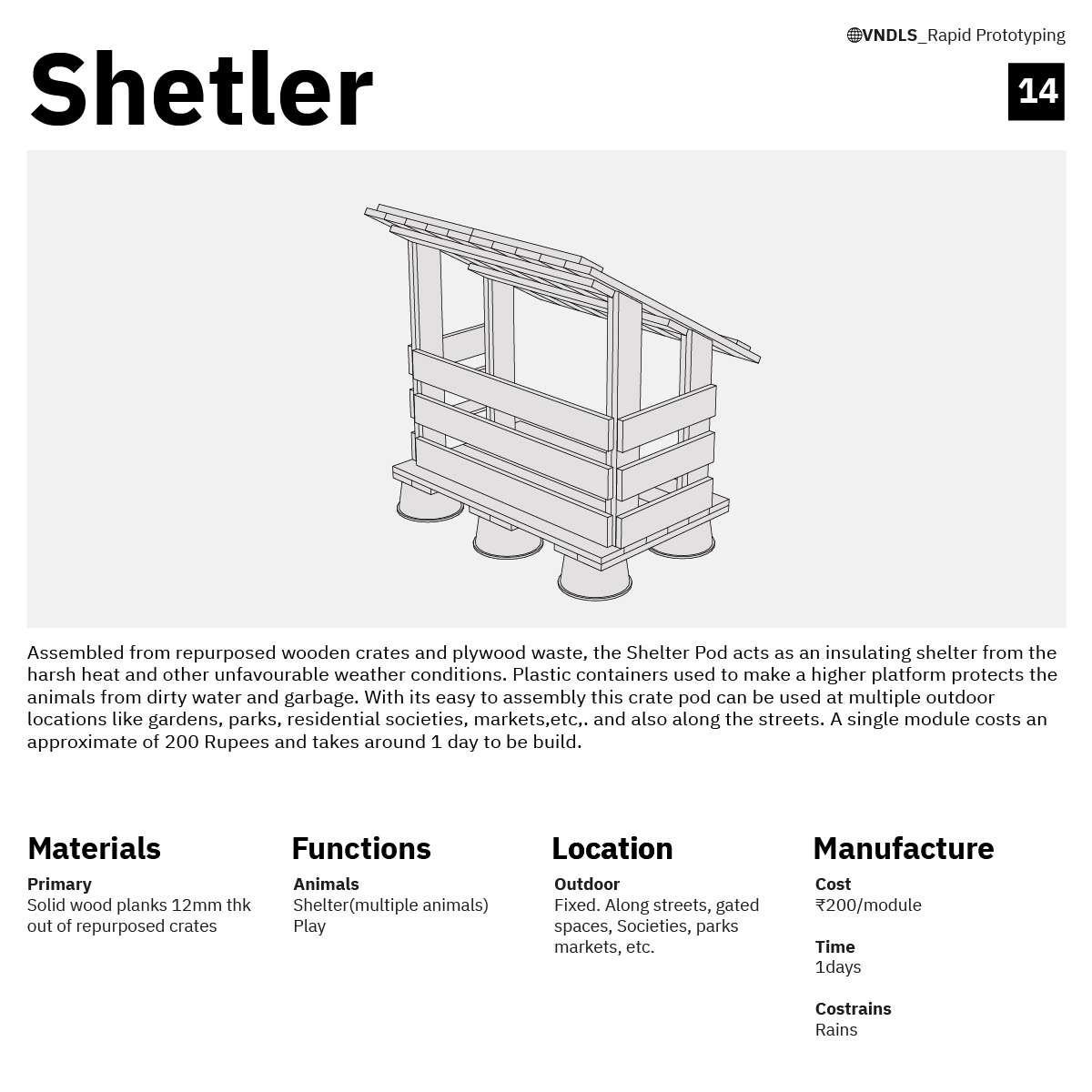



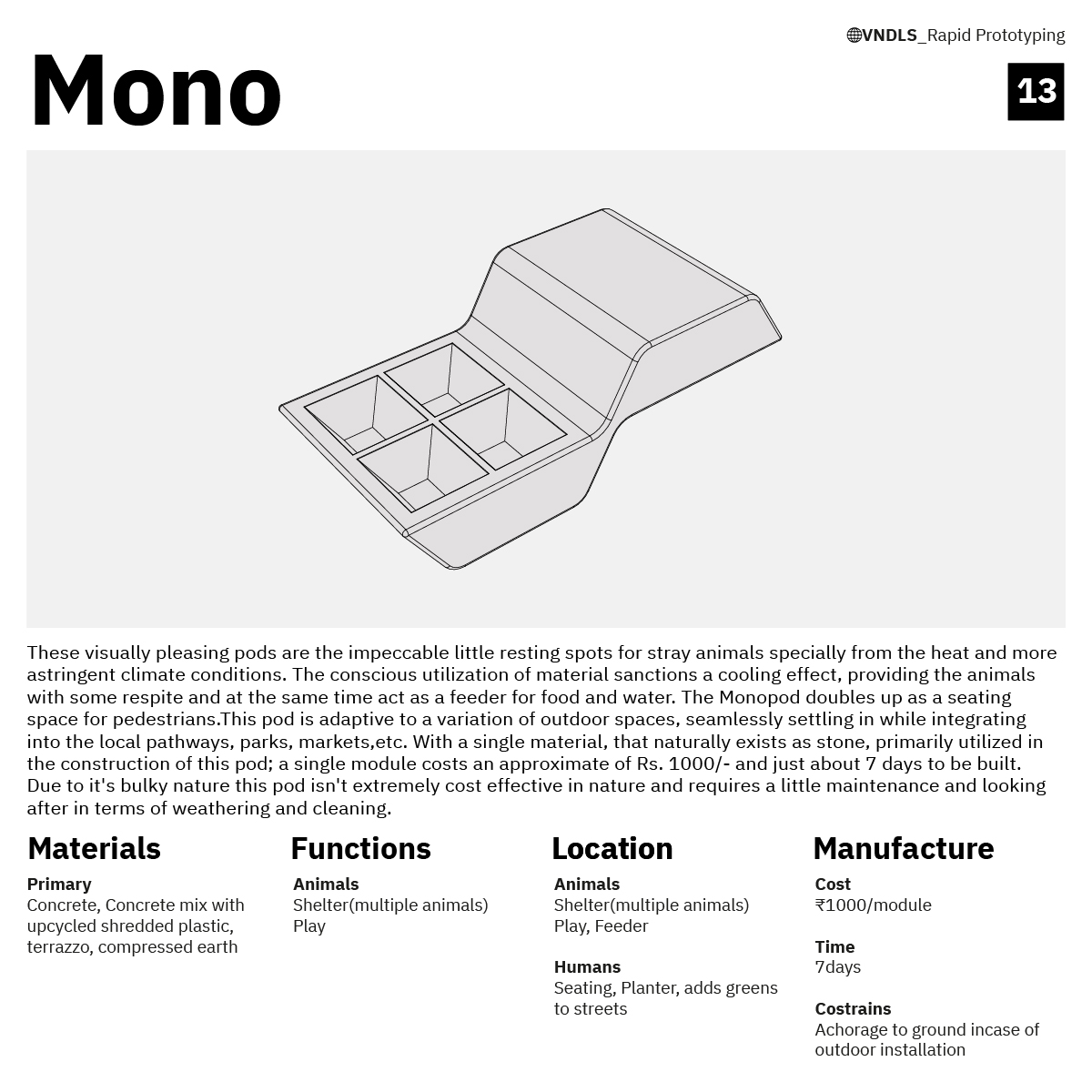





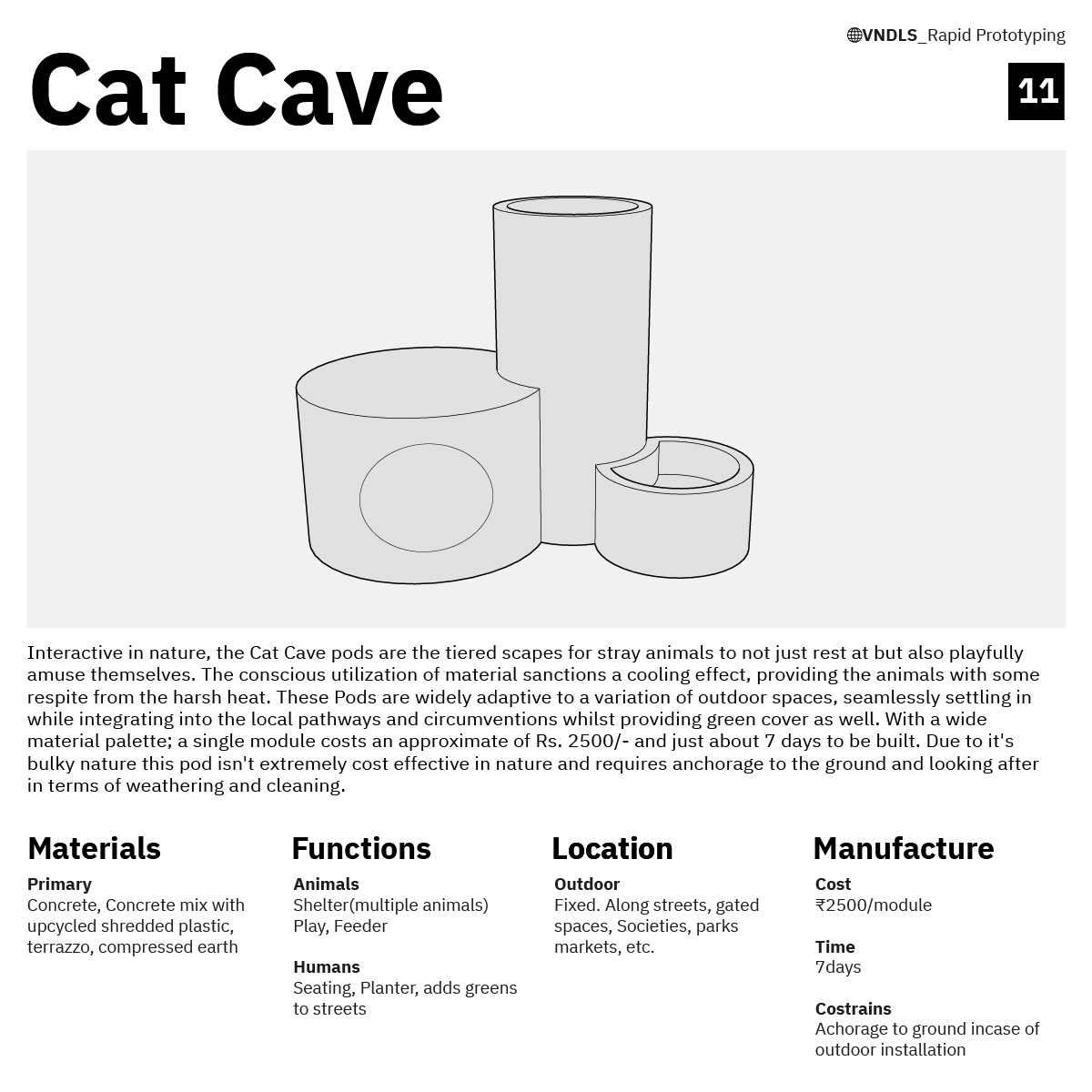










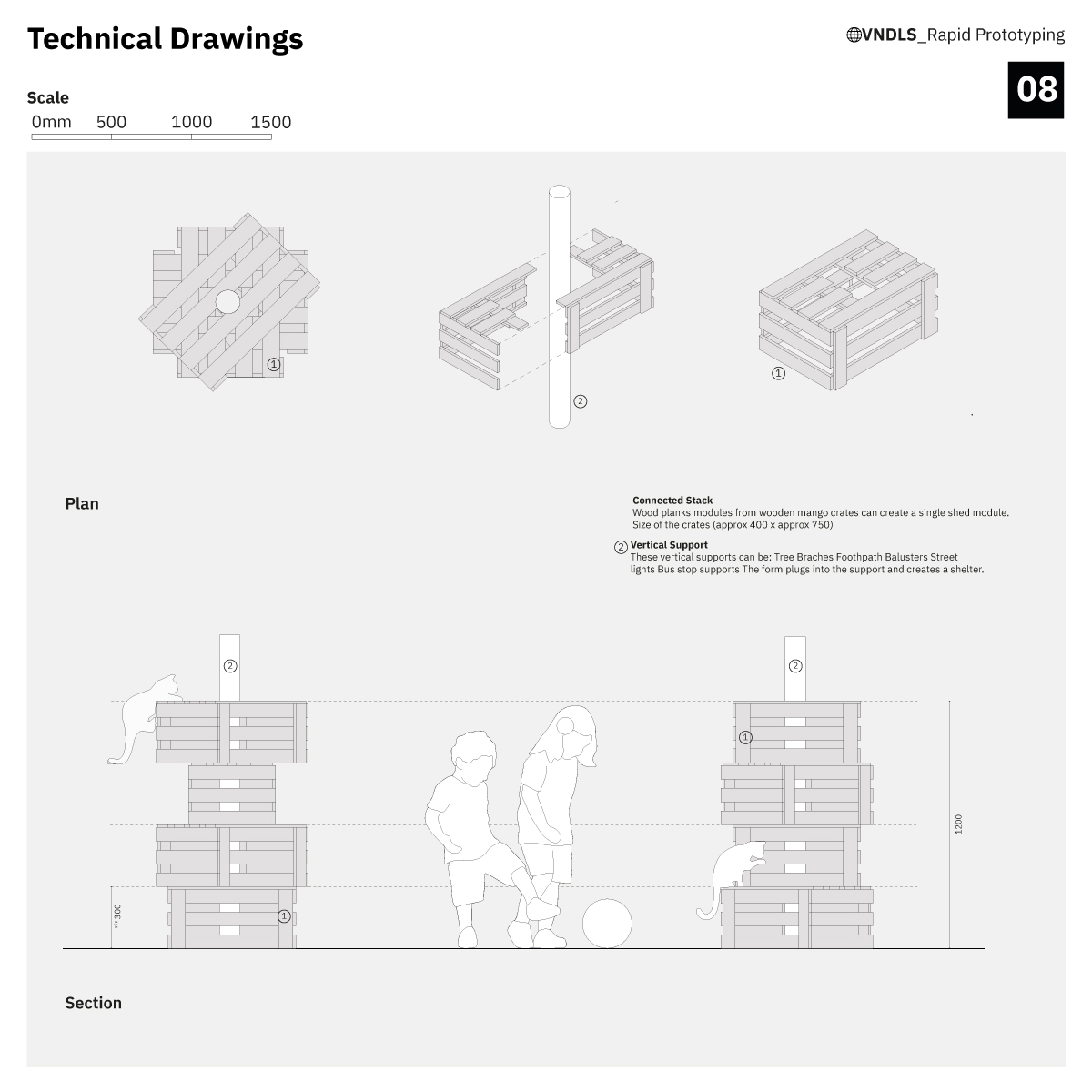

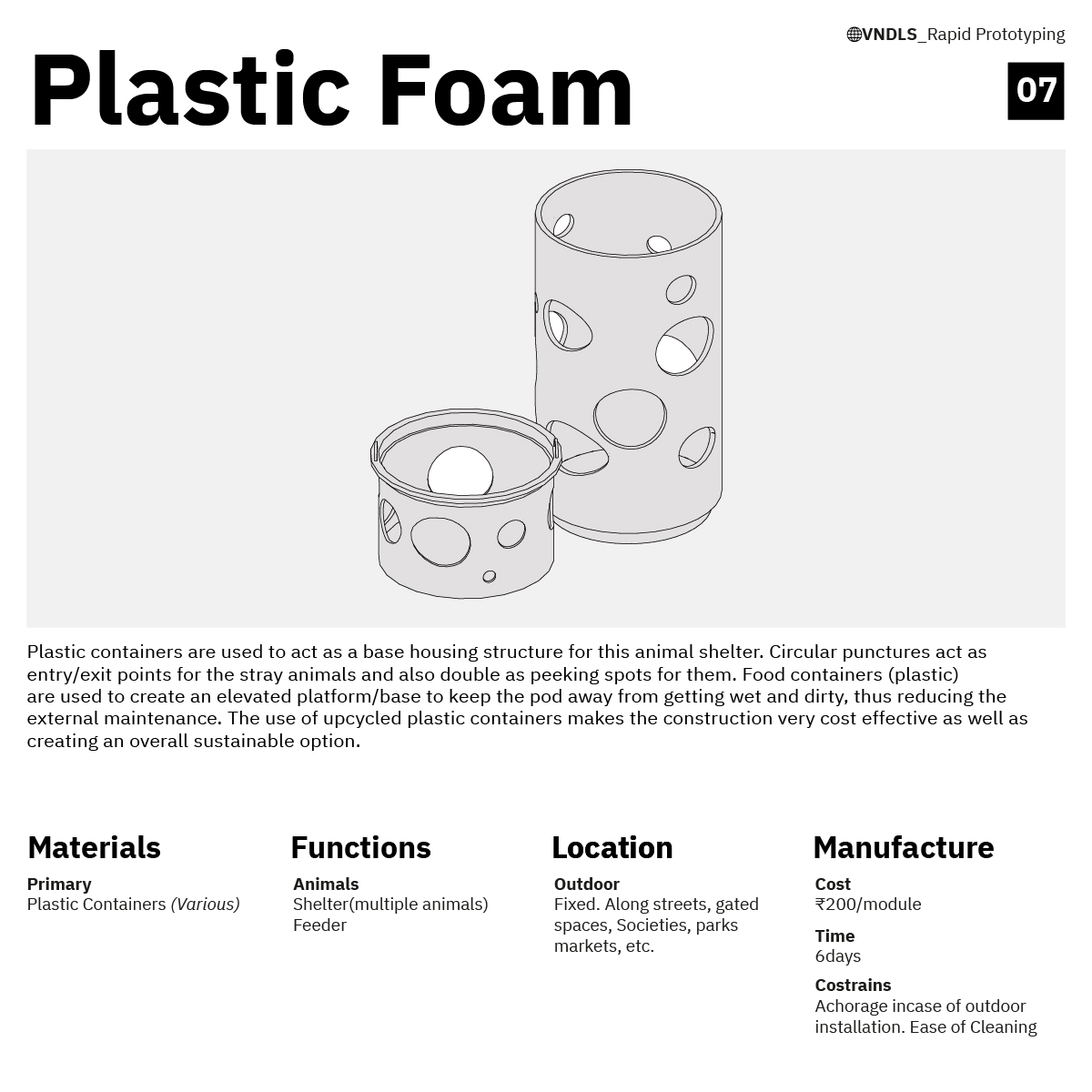
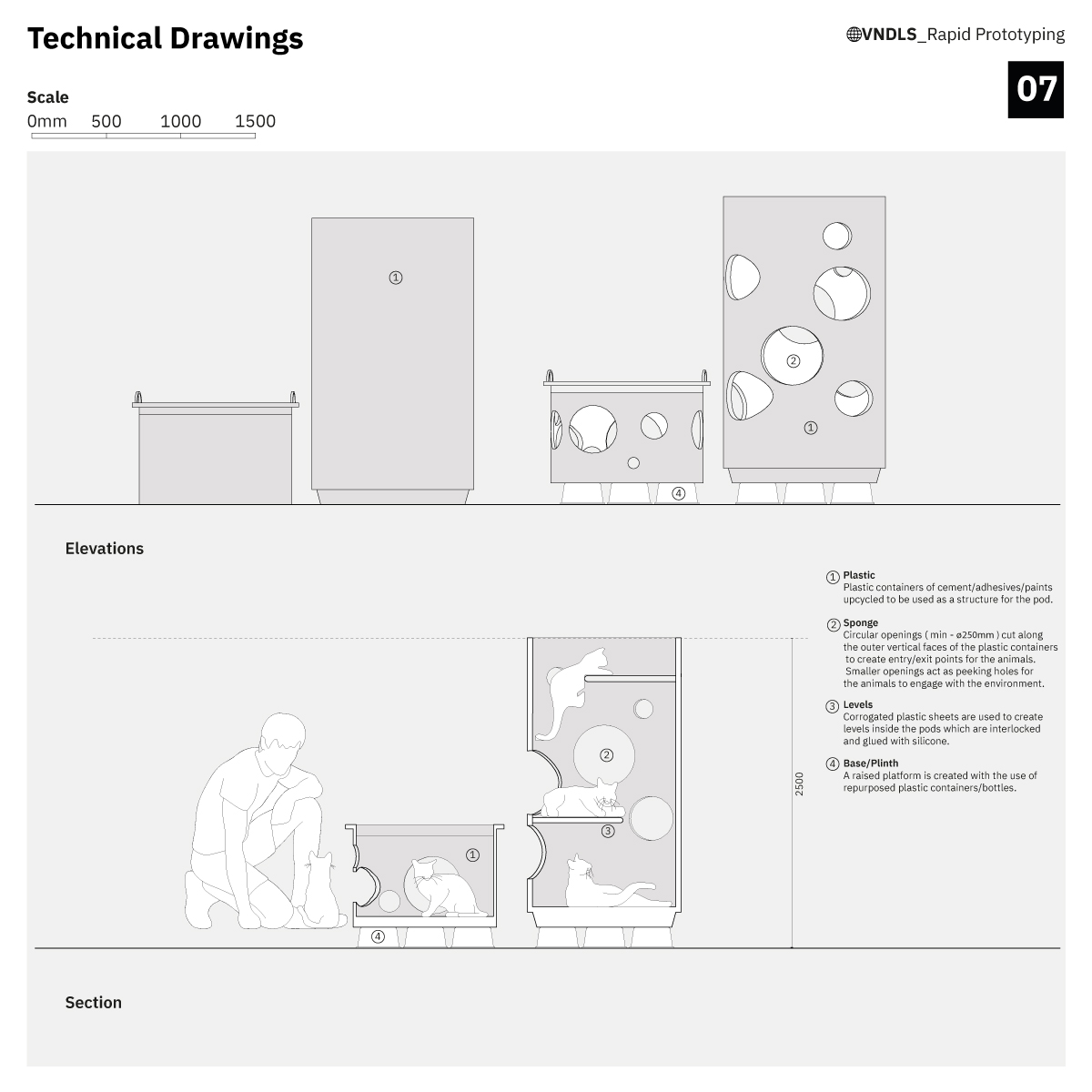

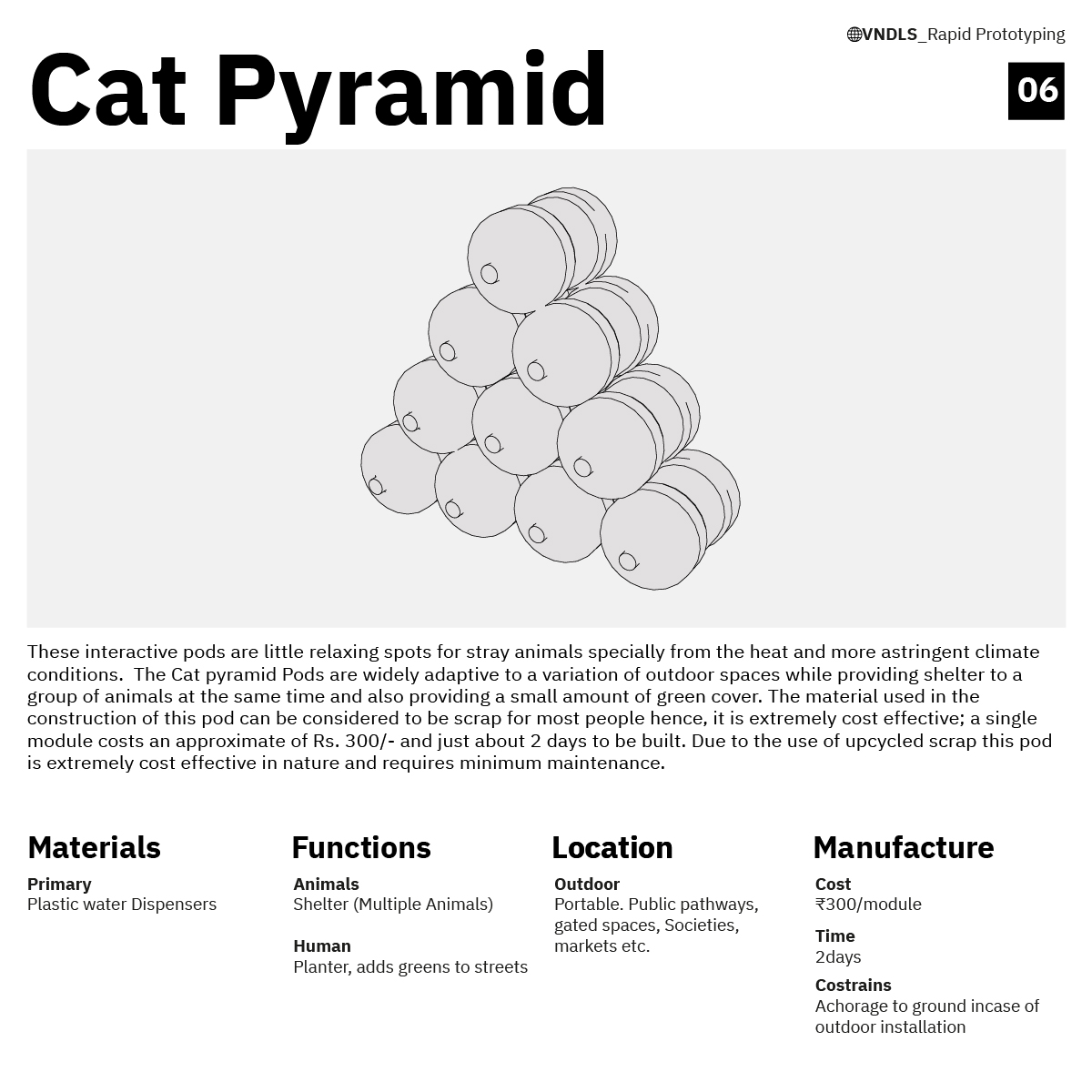



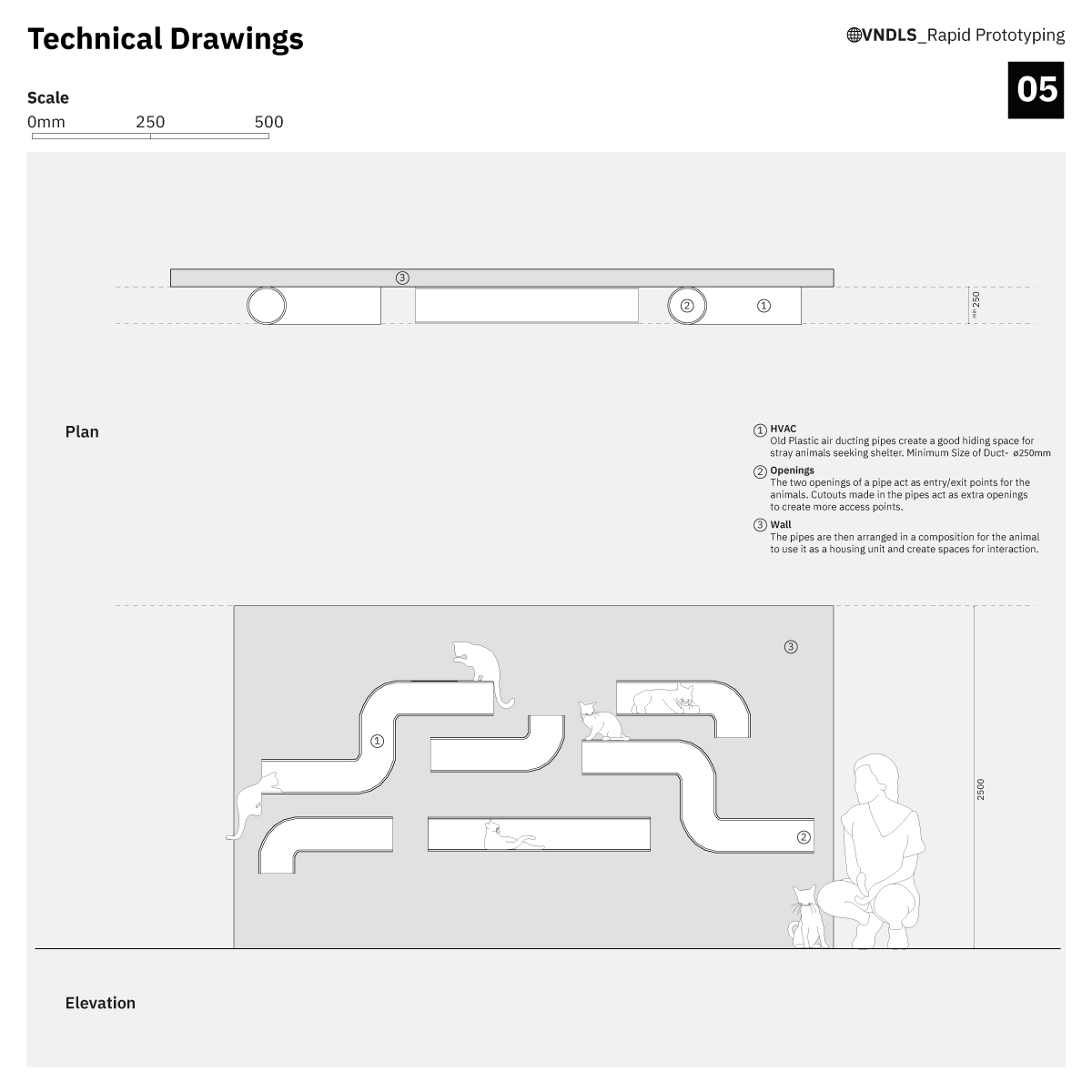





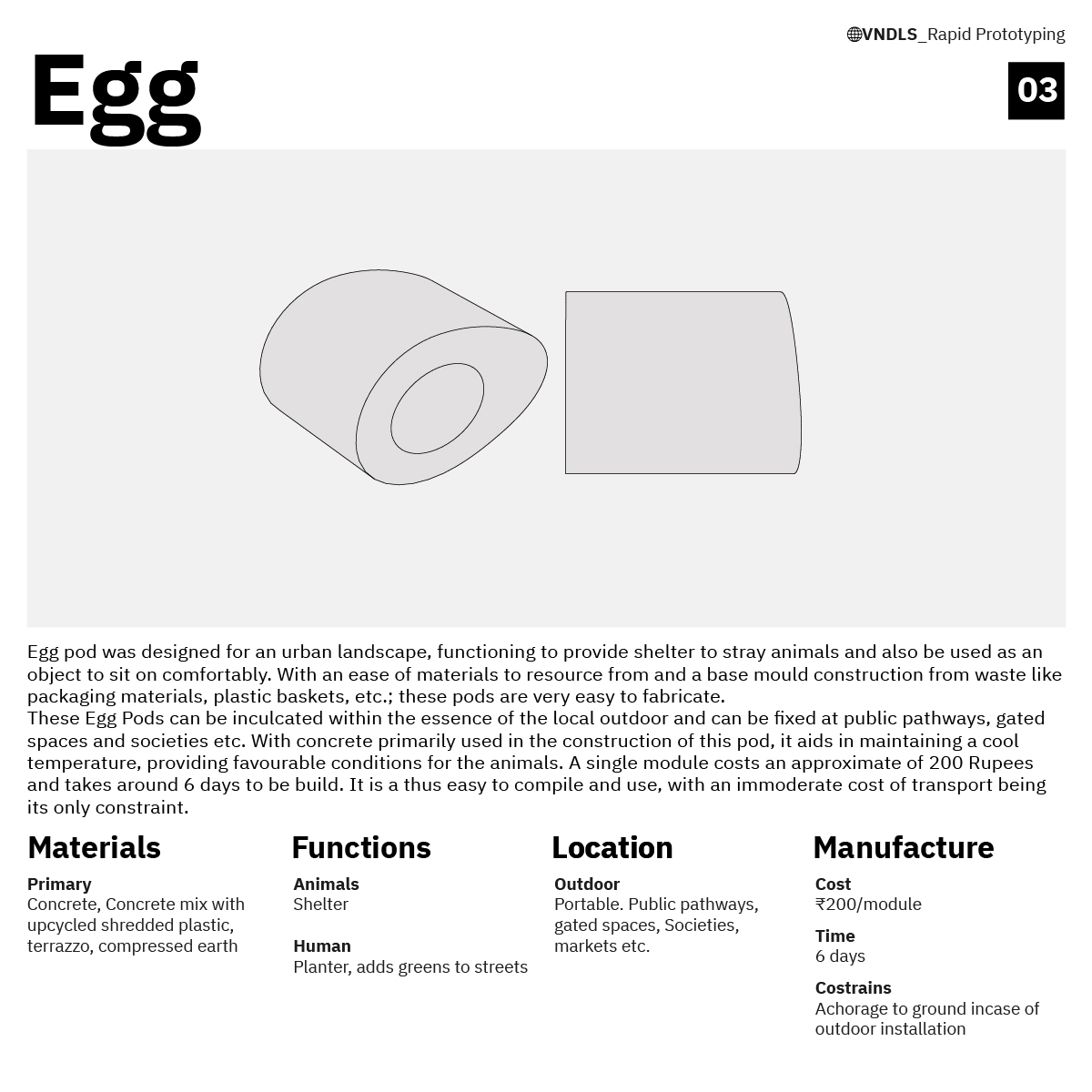
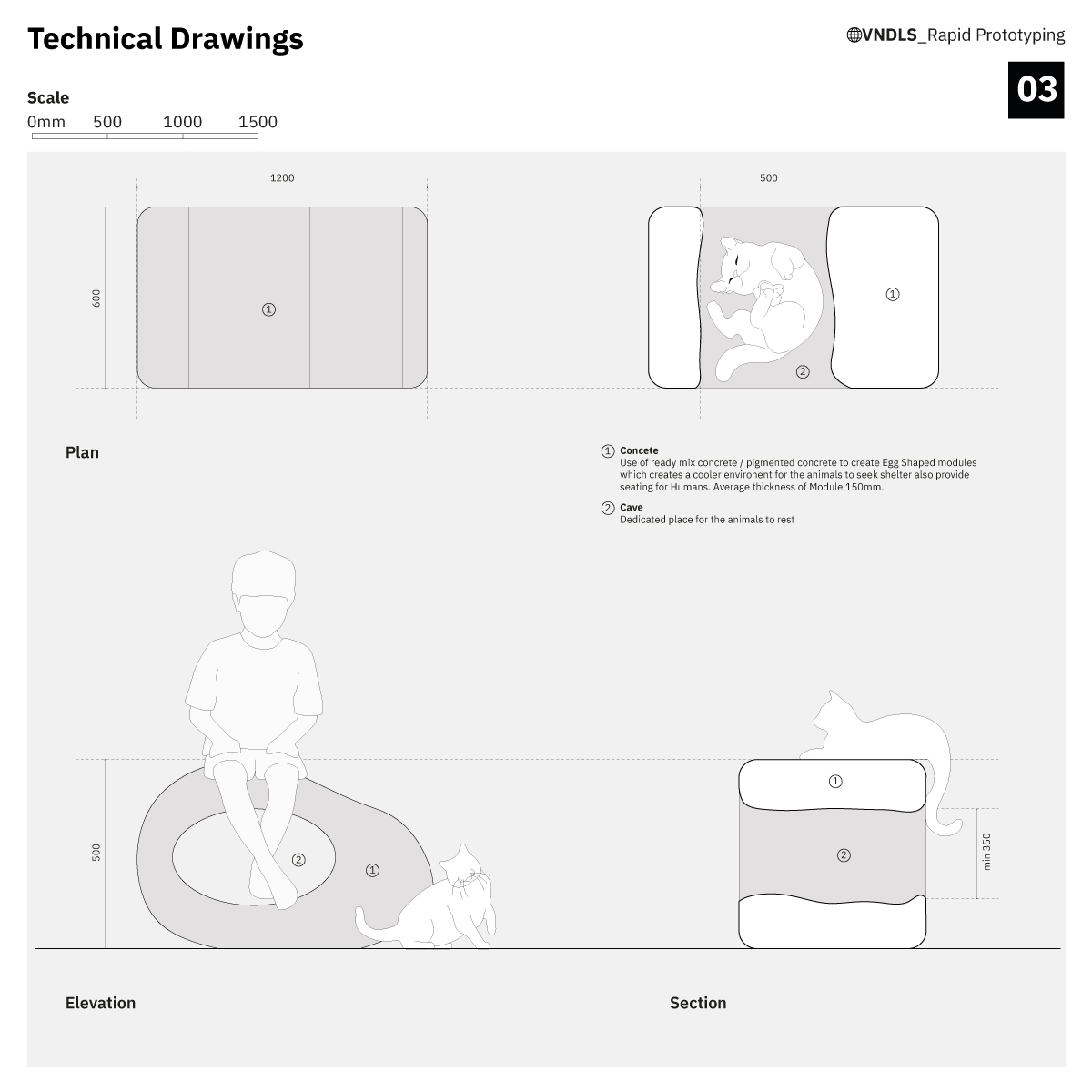

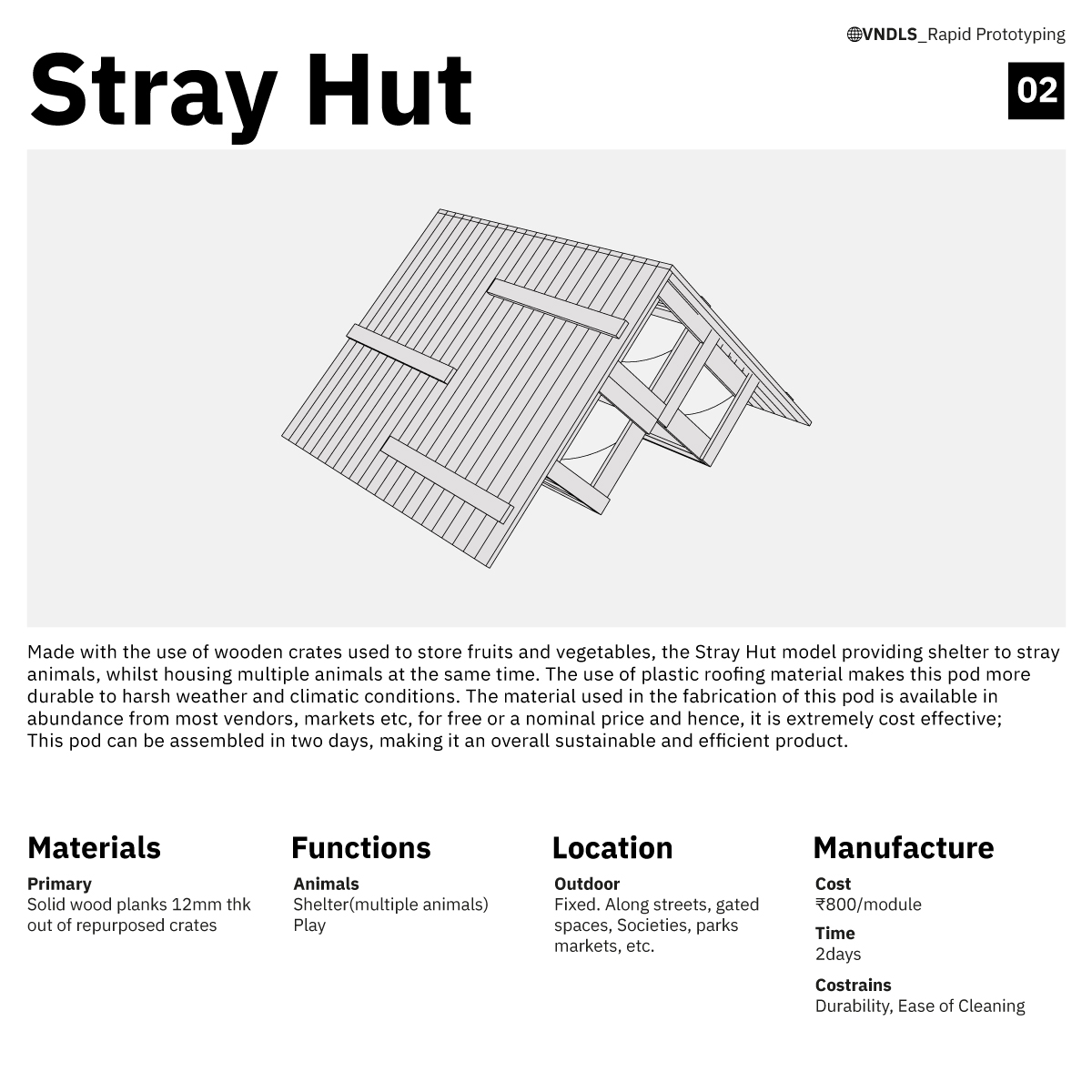
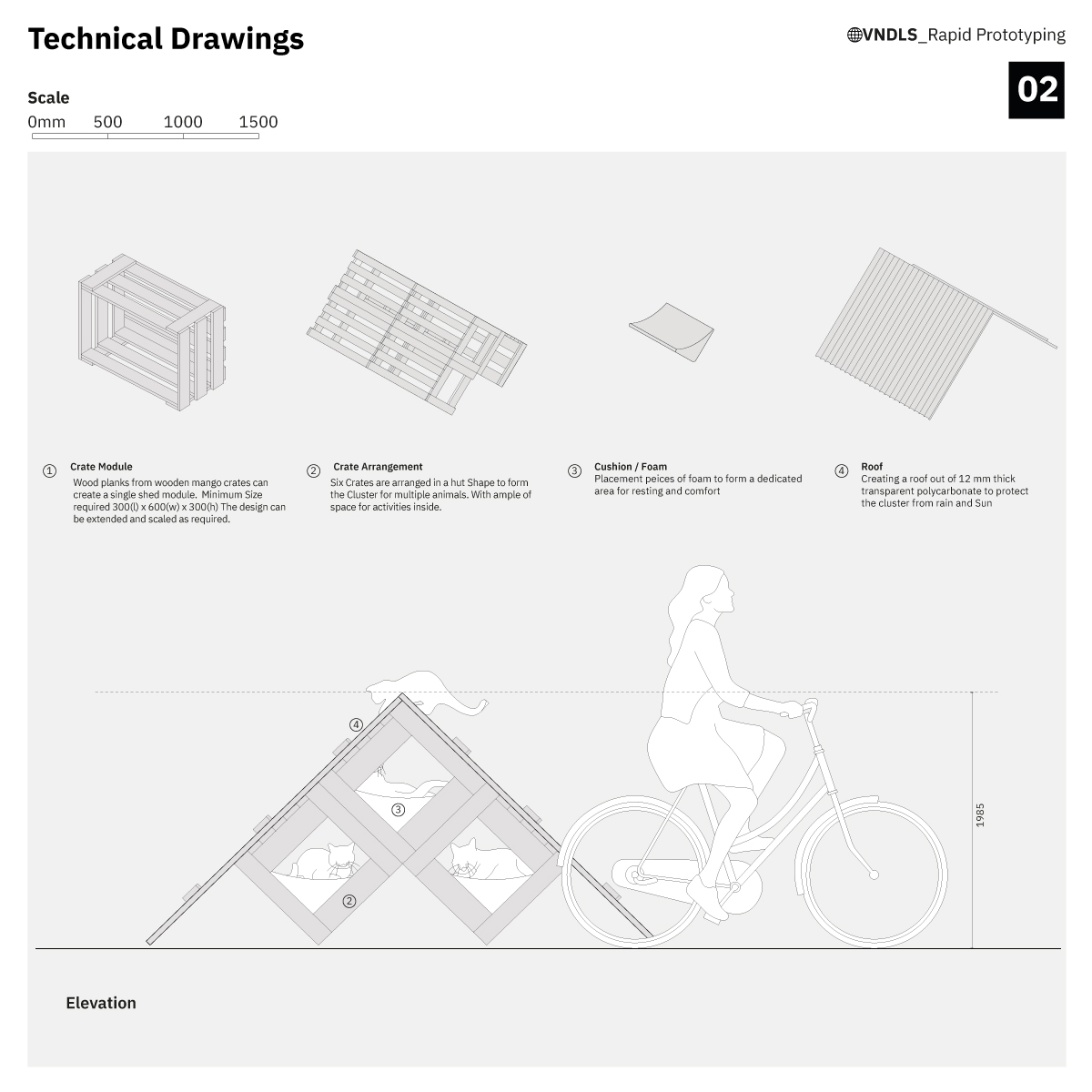

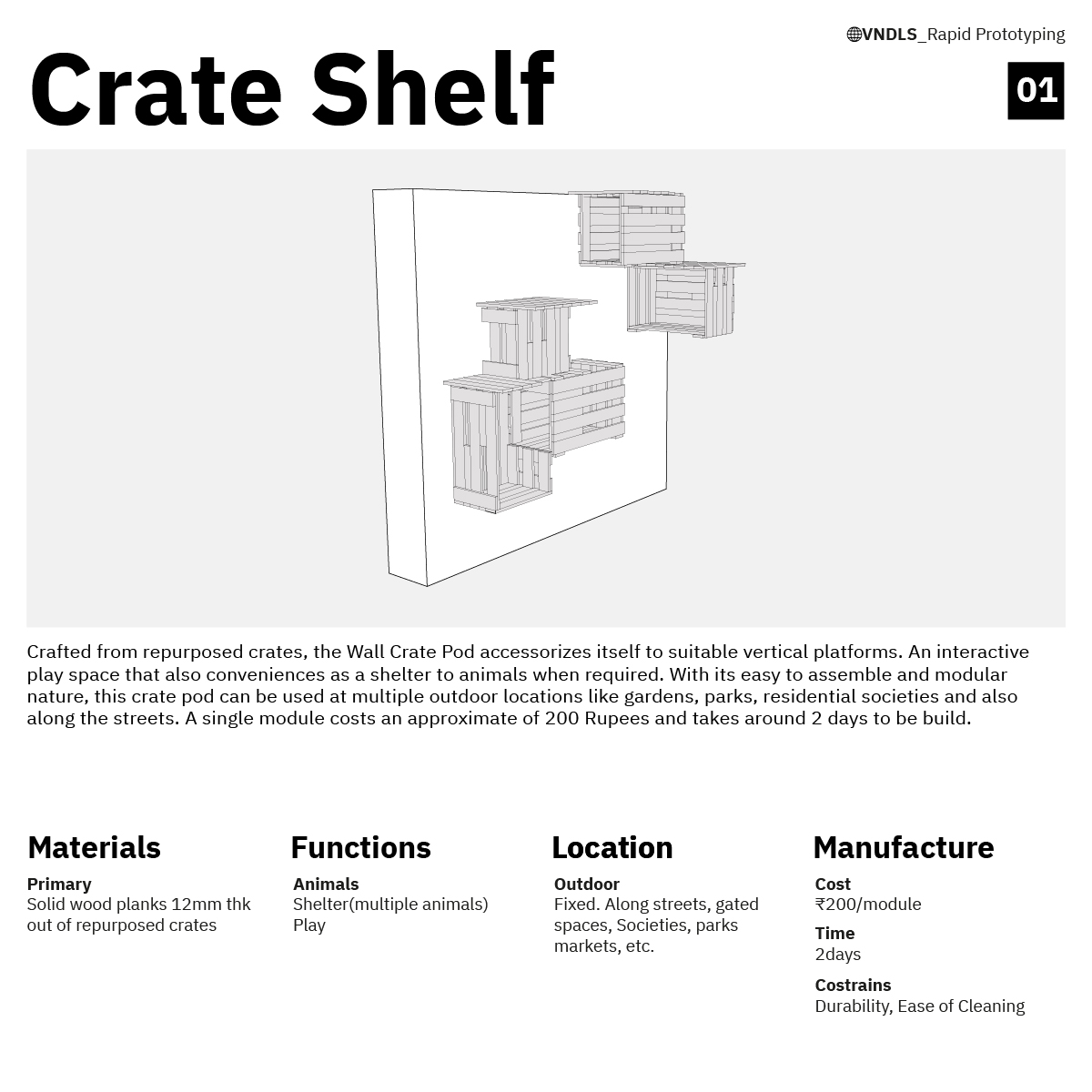
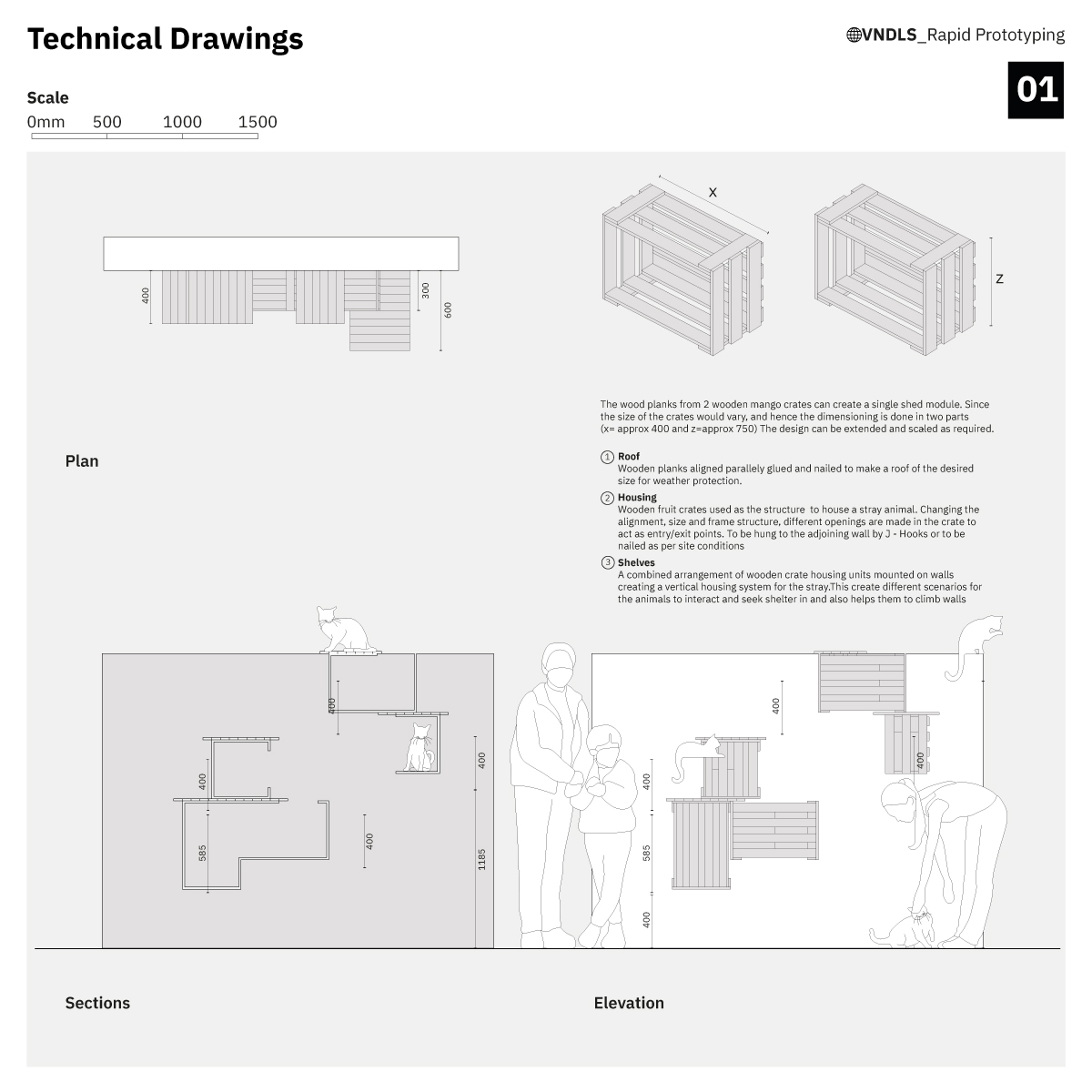

2. Methodology
VNDLS is a group young designers/creative individuals allocating time every Sunday for this project.
We call this the Sunday Service meetings. This is when the group collectively meets holding dialogues towards planning and ideation.
The collaboration has devised a process which mainly involves learning from observation, designing, prototyping and field testing. The group believes in the intimacy involved with creating mock ups and trying them out in actual sizes.
The entire process has been meticulously guided by Faizan Khatri, who has been intensively involved with Animal Research and Design called The Initiative at studio eight twentythree, which houses most cats and dogs from the neighborhood.
The group is also incubates on data collection + analysis, and experiments with story telling in order to guide the designs. Their methodology constantly evolves and expands its horizons organically with each new development that takes form.

3. Design
3.1 Direction
The design intent dabbles between what would be absolute necessities with generous sprinkles of dreams and aspirations. The direction varies from responding to materiality, temporality, efficiency, climate responsiveness, durability, reparability and minimal intrusion to aesthetics, art installation value, high detailing, sustainability, modularity, light weightiness, collapsibility, and cost effectiveness.
3.2 Triggers for Design
a. Material Archive
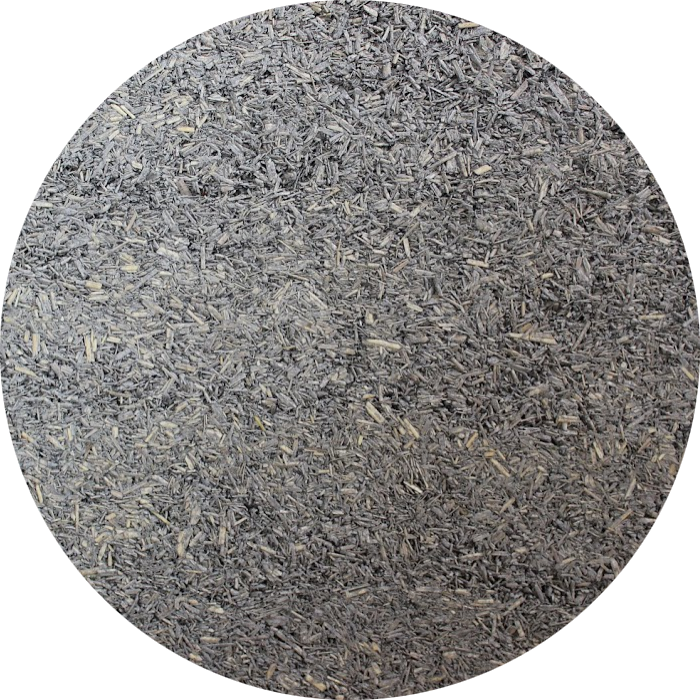
Hempcrete
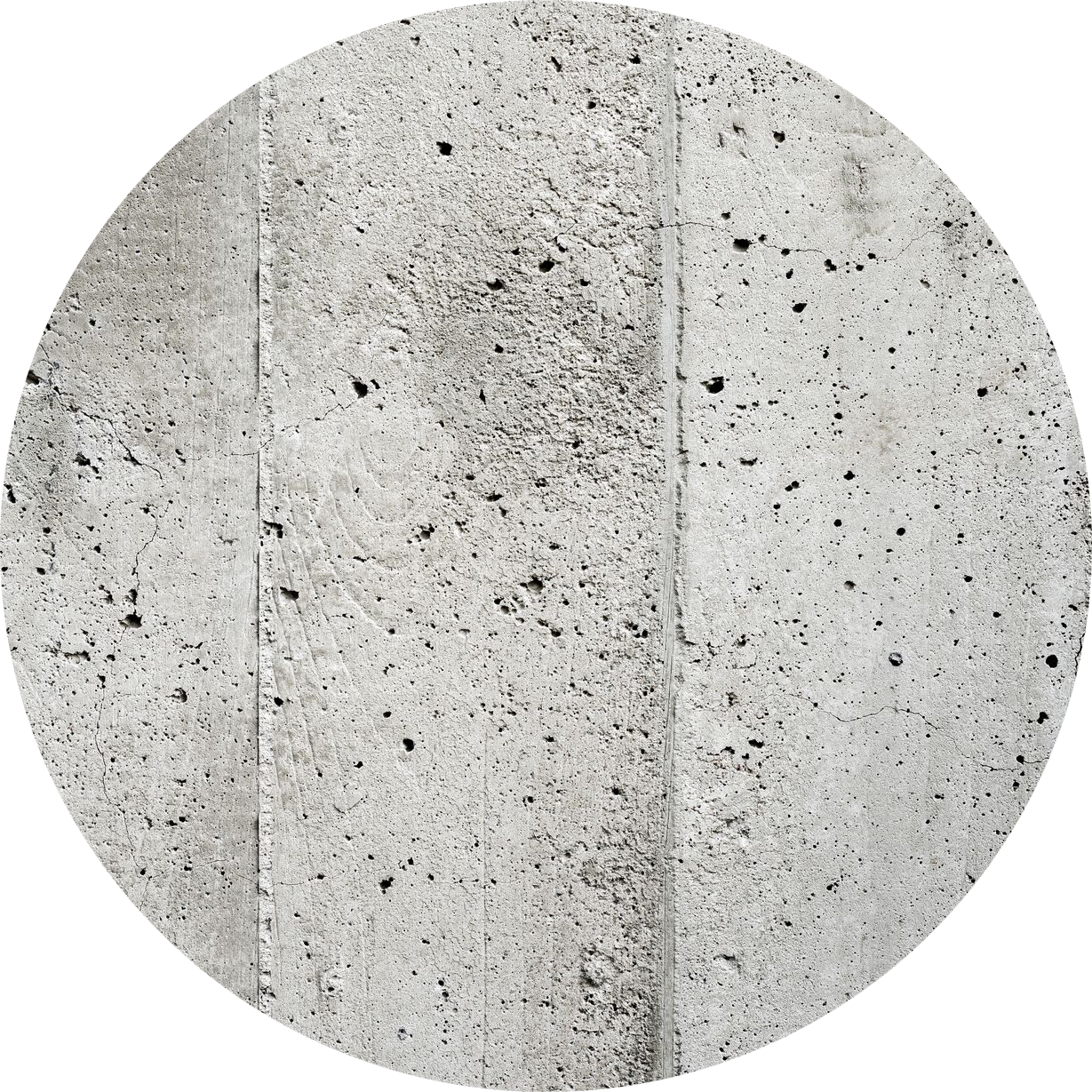
Microconcrete

Acrylonitrile Butadiene Styrene
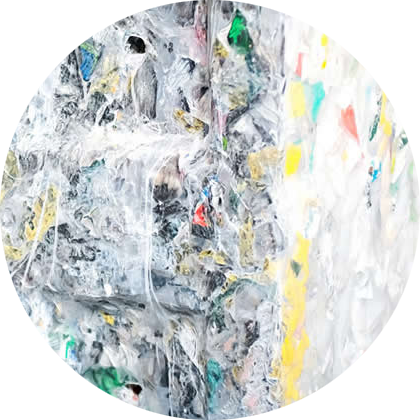
Recycled Plastic Modules
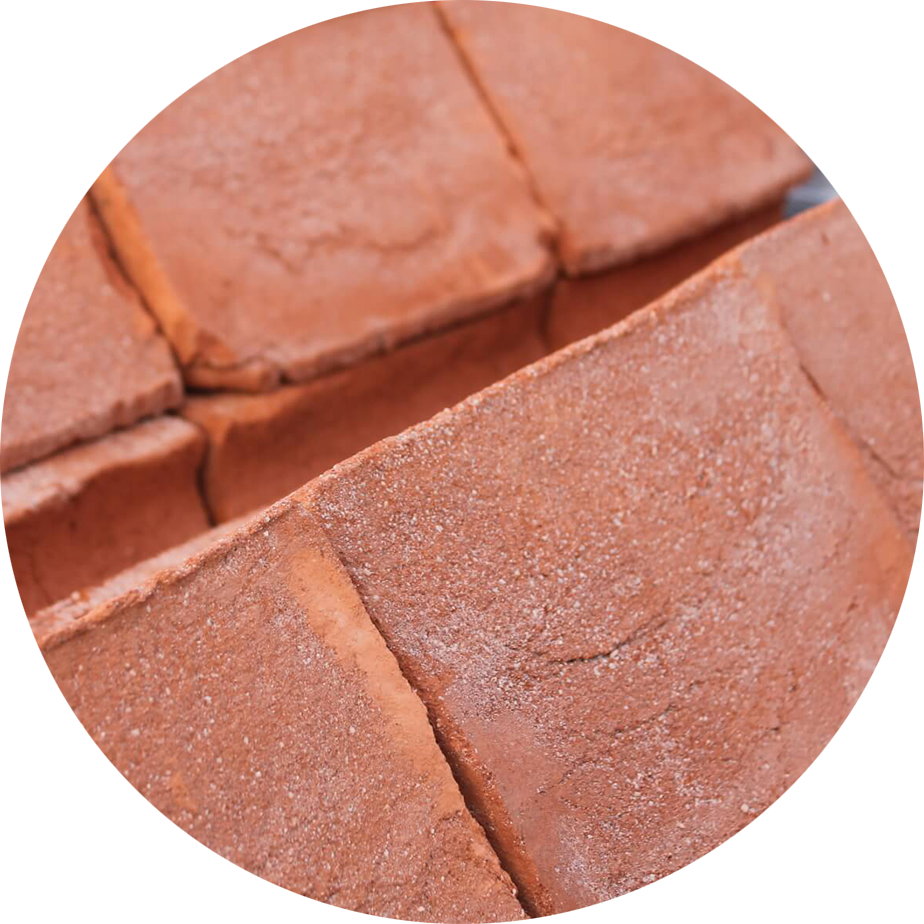
Terracotta
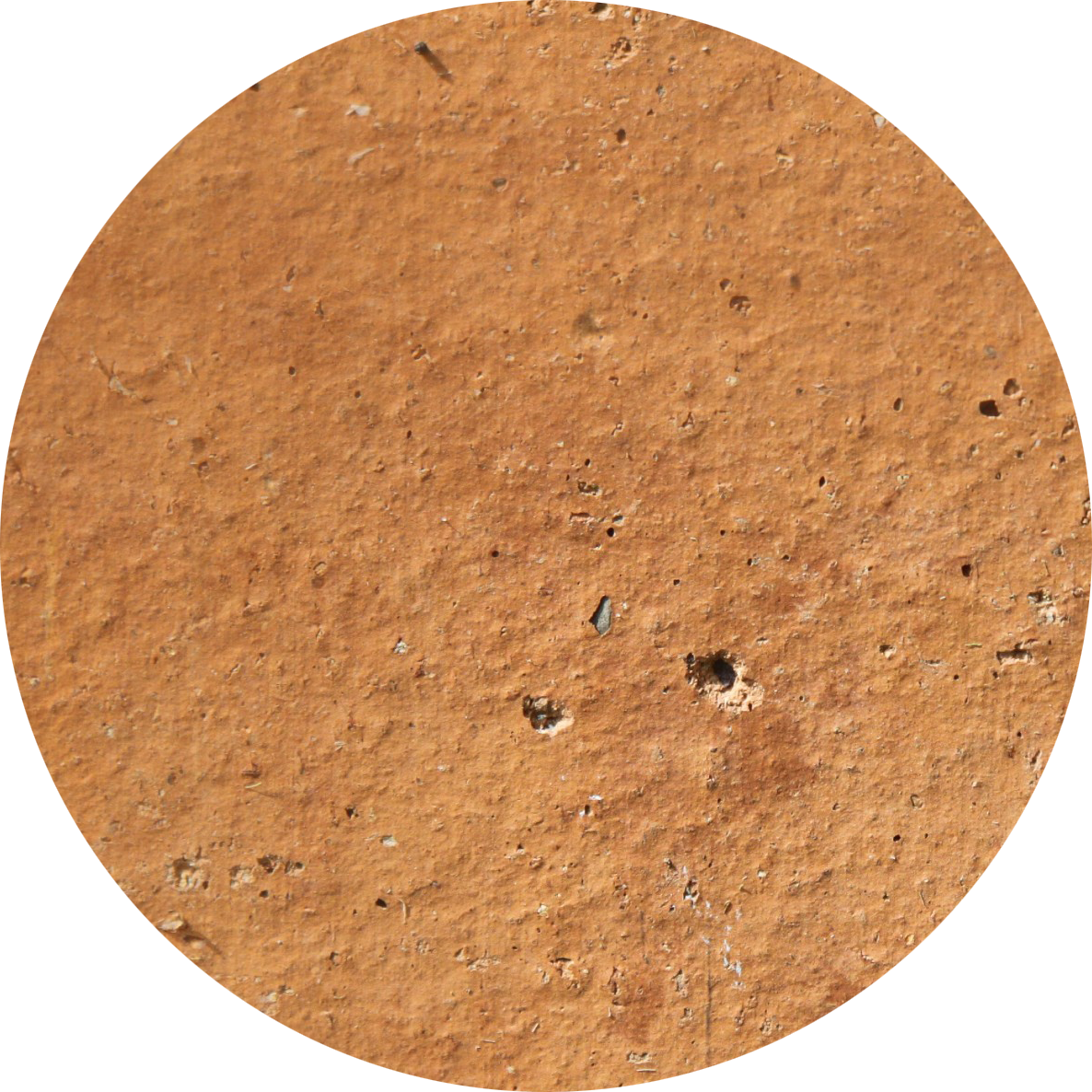
Clay

Waste Fabric

Birch Ply

Tyres
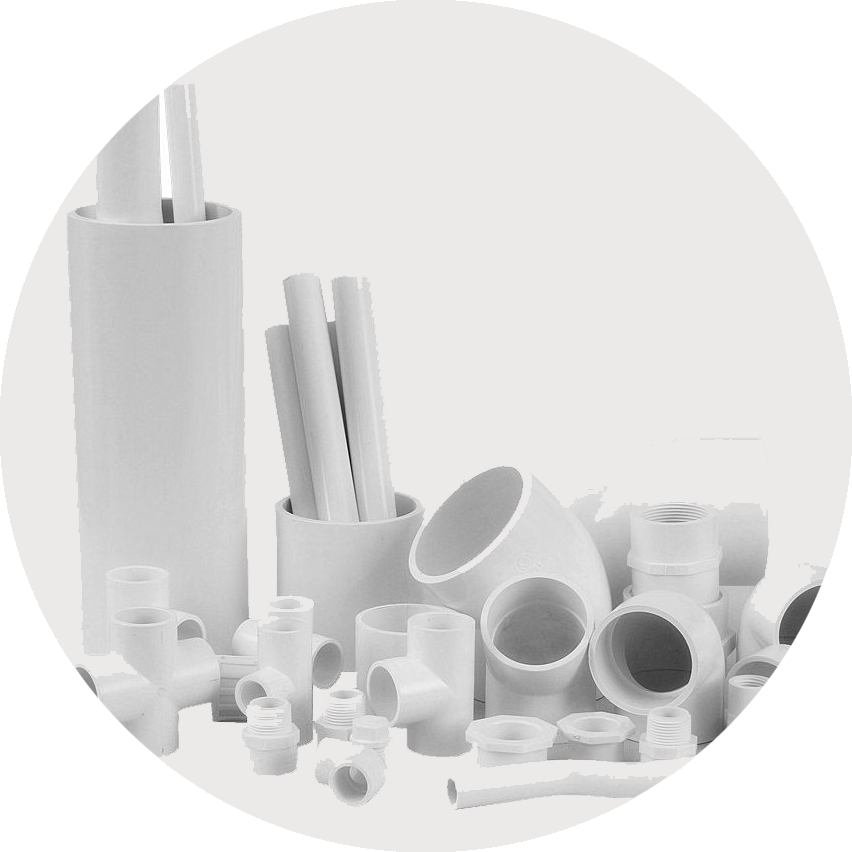
PVC Pipes

Rammed Earth
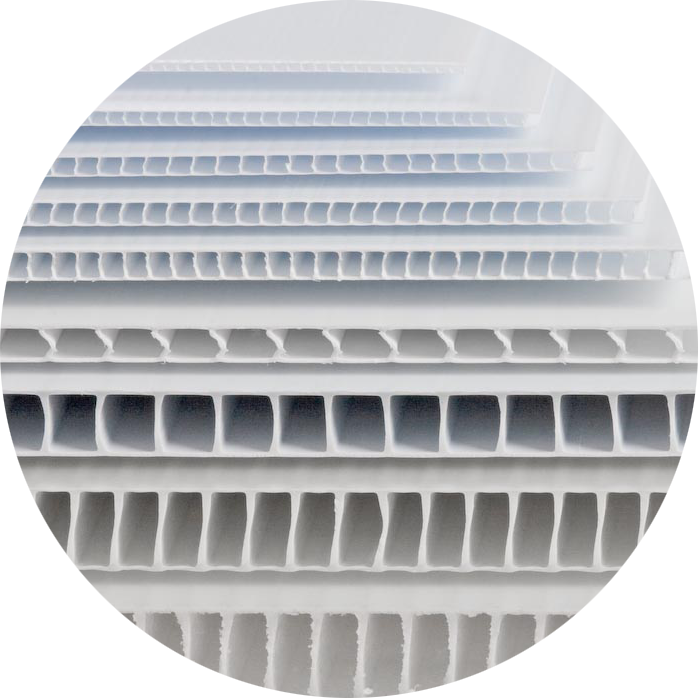
Corrugated Plastic Sheets
b. Identification of Locations for interventions
Mapping places where strays are usually found
•Compound Wall
•Corporate Smoking zones- Ash Trays
•Bus Stops
•Street Furniture: Benches
•Planter Boxes
•Road Dividers
•Gates
•Dustbins
•Tapris
•Gardens
• Street Dwellers
c. Mapping realtime locations for field testing
Shivaji Park
Dadara West
![]()
Dadara West

Skate Park
Carter Road Bandra West
![]()
Carter Road Bandra West

823
Prakash Building Garage, Dadar
![]()
Prakash Building Garage, Dadar
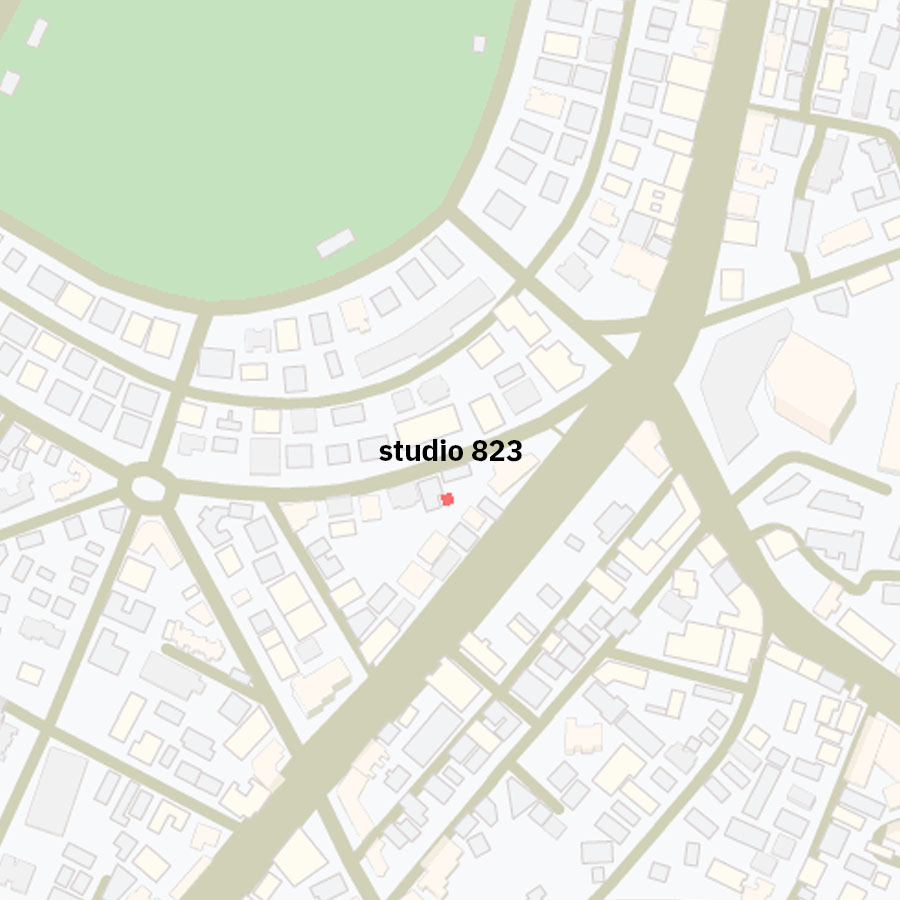
3.3 Prototyping
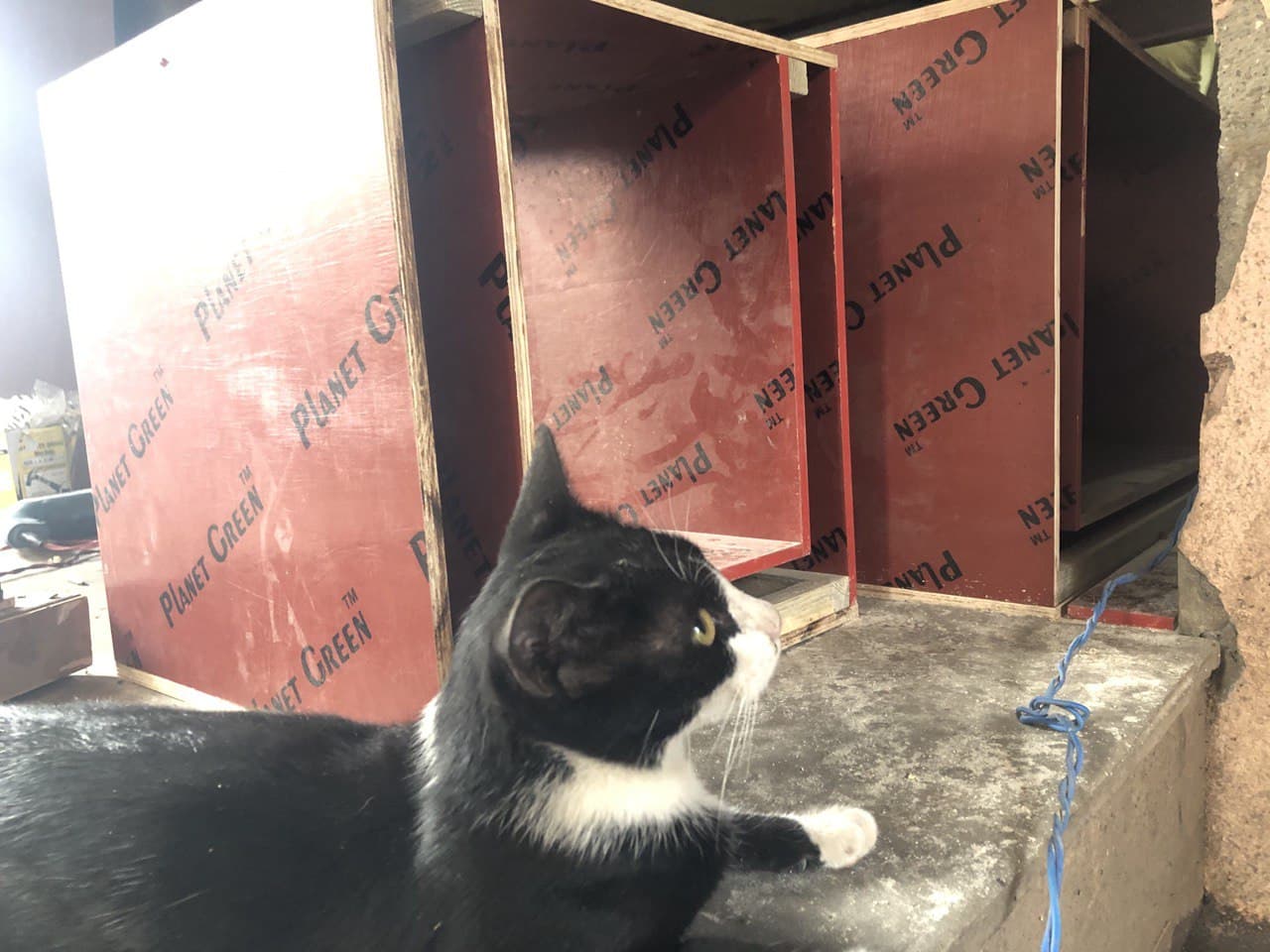







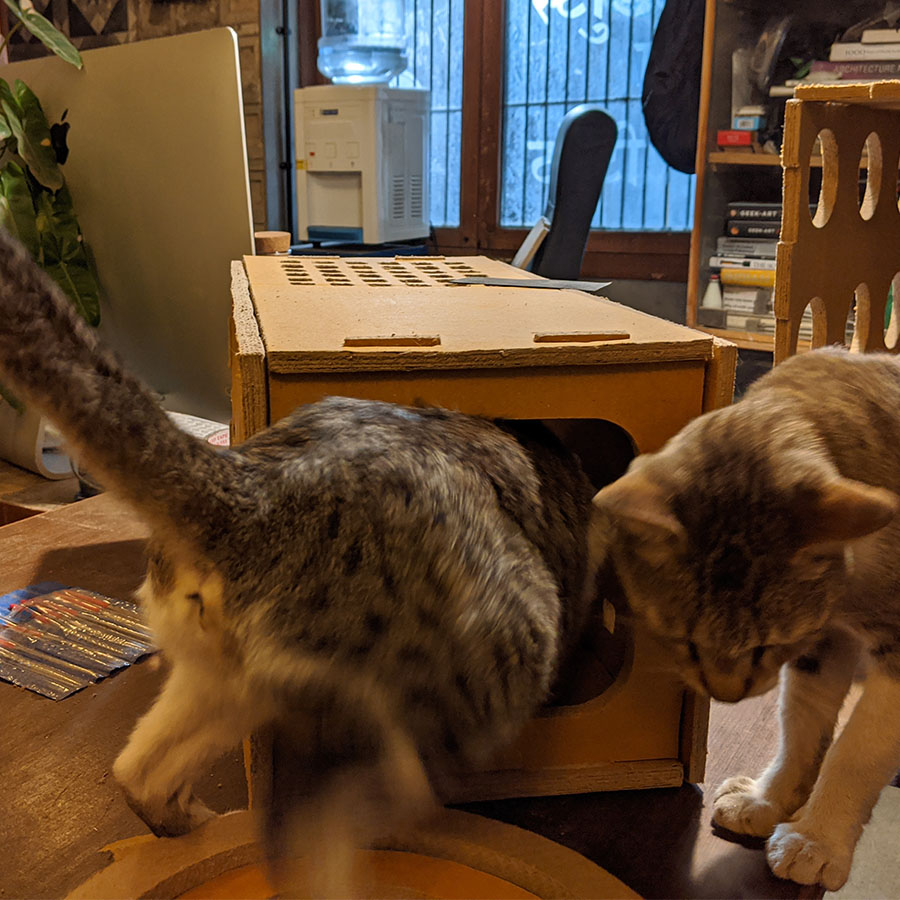
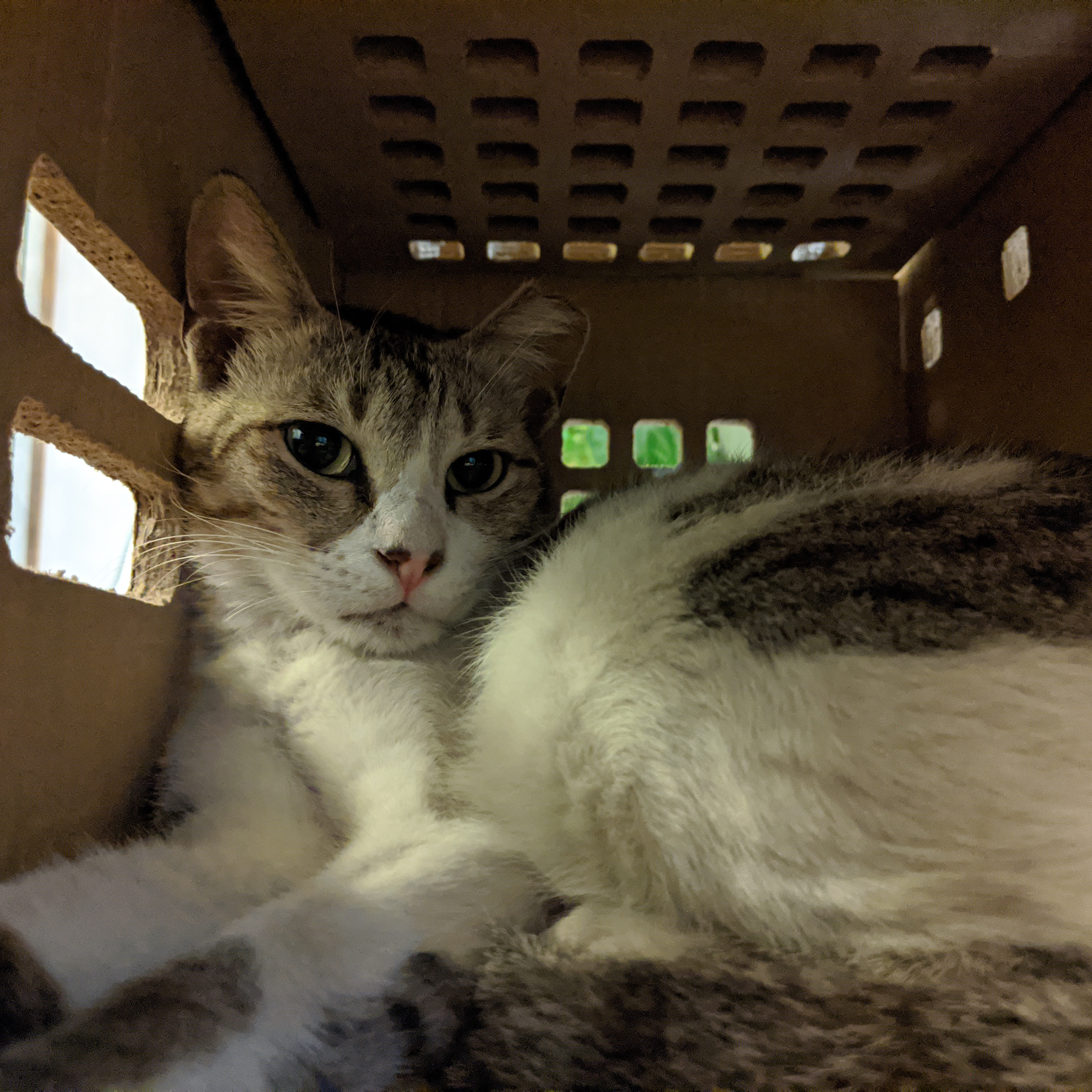
4. General Questions
(1) Why do street animals exist?
Street dogs and feral cats exist in large numbers in developing country like India:
• Human settlements (urban and rural both) inevitably create a noticeable amount of garbage that lies exposed. This essentially enables the street animal’s existence. The animals quickly learn to scavenge. In the absence of this food source, they would have a a tougher time sustaining.
• Couple this with their high reproduction rates and numbers. A female dog gives birth to an approximate of two litters of 4-10 pups each year. Cats have a higher number of three to four litters of up to 3-9 kittens annually. Thus the entire population grows exponentially over years.
• Cities and towns in India have a huge amount of population surviving on the streets (Mumbai has an astonishing 60% of its population living on the streets!). The street dwellers, humans and animals, share a rather strong interdependence with regards to their psychological well-being and security taking care of each other.
• Shopkeepers and others take active interest in tending to the needs of these animals, feeding them and looking out for their health.
(2) Are there laws pertaining to the rights, responsibilties of care-takers and welfare of street animals?
India endorses ahimsa (non-violence) and this has always enabled people to peacefully co-exist with animals. It is a citizen’s duty to show compassion towards all living creatures according to Article 51A(g) of the Constitution. A fundamental freedom guaranteed to the citizens of India, is the freedom to choose the life they wish to live, which includes facets such as living with or without companion animals and moreover assigns a duty to ensure animals are taken care of and respected whist watching out for any kind of cruelty towards them. Resident Welfare Organisations and Apartment owners associations cannot object pets as companions and cannot form laws against it, neither against permissible ways of housing and feeding street animals within society boundaries, even by majority. A “ban” for animals/pets is considered illegal by the law.
Although the AWIB recognises pet owners and care givers to stray animals as different entities, their duties and responsibilities intersect. A pet owner or a stray care giver, should ideally take care of the health, sterilisation, and vaccination of the animal. This can either be done privately or with the help of animal welfare organisations.
Personally, it is the responsibility of the owner or the care giver to maintain cleanliness and hygiene where the animal defecates, lives and feeds.
They also have to make sure that the animals are not a nuisance to others around them.
The Animal Welfare Board of India (AWBI) has listed down in detail, all acts, rules and laws pertaining to the rights of animals and prevention of cruelty on their website. (http://www.awbi.in/policy_acts_rules.html )
(3) Are there any provisions to keep the street animal population under control?
Large populations of stray dogs and cats turn into public health concerns. Dog bites, rabies, leptospirosis, cat scratch fever, and so on are all risks for people living in areas with large populations of strays which often leads to territorial fights and incessant barking at nights. While it’s important to ensure the welfare of street animals, it’s equally important to keep a check on their population to control the spread of diseases and prevent possible bites and attacks.
Animal Welfare Board prescribes Animal Birth Control Rules, 2001 (ABC) as the only effective methodology of keeping the street animal population under check along with vaccinations. The Honorable Supreme Court of India has further ordered the implementation of the ABC program to control the street dog population in all states of India since 2015.
ABC involves spaying of females and castration of male dogs so that they do not reproduce. Vaccination involves giving the dogs an anti- rabies shot. After sterilization the dogs do not reproduce and hence their population becomes stable. As they are vaccinated against Rabies and other diseases they do not pose any health hazard and live out their natural lives healthily and harmlessly, while protecting their territories from other aggressive dogs that may want to enter.
NGOs / individuals take up responsibilty to assist with ABC in their respective areas of functioning via a closed network of communication.
(4) What are the broad categories of differentiation in animal identification as a pet / a street animal?
Definitions are based on two quantifiable parameters: the level of an animal's dependency on humans and the level of its restriction by humans (World Health Organization, 1988).
The first of these refers to the intentional provision of those needs, such as food, shelter and care, necessary for the survival and well-being of the animal. Although it was recognized that this dependency of animals on humans was a gradient ranging from total dependency to none, the following three categories of dependency were proposed:
•Full dependency – the animal is given all of its essential needs intentionally by humans
•Semi-dependency – the animal is given some of its essential needs intentionally by humans
•No dependency – the animal is given none of its essential needs intentionally by humans.
The second parameter, restriction by humans, refers to the control of any contact, association and communication with other animals and people, either through physical restriction (e.g. confinement to premises, leashing) or through direct supervision and control when outside the premises. Again, three categories of restriction are recognized:
•Full restriction – fully restricted or supervised
•Semi-restricted – movements and associations only partially restricted
•No restriction – not subject to any restriction whatsoever.
Four broad categories of animals which exist:
•Restricted animal – fully dependent on their owners and fully restricted or supervised
•Family animals – fully dependent on their owners, but movement and contacts only partially restricted
•Neighborhood animals – partially dependent on the intentional fulfilment of basic needs by humans, but subject to only partial or no restriction
•Feral animals – independent of intentional human provisioning and unrestricted.
5. File Archive
Member access onlyVNDLS_Data Archive
VNDLS_Material Archive
VNDLS_Design Archive
VNDLS_Interview Survey
VNDLS_WriteUp
6. Timeline Archive
15 Dec 2019// Introductions and defining Path
22nd Dec 2019// Taking up tasks and triggering fabrication 05th Jan 2020// Research Structure, Tyre Ideation, Scans First Look, Identity Initiation 12th Jan 2020// Format and story telling discussion 19th Jan 2020// Format Documentation Parameters, AWBI laws, Prototype Model, first draft of story telling 26th Jan 2020 // Casted Billi Bowl, Tyre Material, Finalise format
9th Feb 2020// Taj mahal Tea house, Mini Review 16th Feb 2020// Interview discussion, Format, Design upgrades, Field Days, Funding and crowd funding options 23rd Feb 2020// Finally we review + Google Drive Set up
27th Feb 2020 // Tyre Prototype at Pendses
5th March 2020 // Design Digital Documentation
15th Mar 2020 // Google Drive Organisation, Web Documentation Beta 1.0, Pod Illustrations
26th March 2020 // Google Hangout Call
29th March 2020 // Sharing Speculative futures and the collective dialougue around it
5th April 2020 // Web Documentation Beta 2.0
11th April 2020 // Web narrative review
19th April 2020 // Conference call to assign tasks
1st May 2020 // Web Documentation Beta 3.0
2nd May 2020 // Tasks during the lockdown
6th May 2020 // Web 4.0
20th May 2020 // Meet to organise excels, tech sheets and illustration mock
31st May 2020 // Final Web + Revamp with material archive and text updates
6th June 2020 // Drop down menu Web, Kutta kisko bola
7th June 2020 // Tech Sheets, Crate Designs, Illustrations, The initiative Logo, Material based methodology
14th June 2020 // Tech Sheets, Crate Designs
21st June 2020 // Initiative Web Incubation
28th June 2020 // New Crate Designs, Lego Pods
22nd Dec 2019// Taking up tasks and triggering fabrication 05th Jan 2020// Research Structure, Tyre Ideation, Scans First Look, Identity Initiation 12th Jan 2020// Format and story telling discussion 19th Jan 2020// Format Documentation Parameters, AWBI laws, Prototype Model, first draft of story telling 26th Jan 2020 // Casted Billi Bowl, Tyre Material, Finalise format
9th Feb 2020// Taj mahal Tea house, Mini Review 16th Feb 2020// Interview discussion, Format, Design upgrades, Field Days, Funding and crowd funding options 23rd Feb 2020// Finally we review + Google Drive Set up
27th Feb 2020 // Tyre Prototype at Pendses
5th March 2020 // Design Digital Documentation
15th Mar 2020 // Google Drive Organisation, Web Documentation Beta 1.0, Pod Illustrations
26th March 2020 // Google Hangout Call
29th March 2020 // Sharing Speculative futures and the collective dialougue around it
5th April 2020 // Web Documentation Beta 2.0
11th April 2020 // Web narrative review
19th April 2020 // Conference call to assign tasks
1st May 2020 // Web Documentation Beta 3.0
2nd May 2020 // Tasks during the lockdown
6th May 2020 // Web 4.0
20th May 2020 // Meet to organise excels, tech sheets and illustration mock
31st May 2020 // Final Web + Revamp with material archive and text updates
6th June 2020 // Drop down menu Web, Kutta kisko bola
7th June 2020 // Tech Sheets, Crate Designs, Illustrations, The initiative Logo, Material based methodology
14th June 2020 // Tech Sheets, Crate Designs
21st June 2020 // Initiative Web Incubation
28th June 2020 // New Crate Designs, Lego Pods
Thane Site Visit 1
28th August 2020 // Mono Pod Proposal
6th October 2020 // Site Visit 2
6th-18th October 2020 // Sorting Out Material and Labour
20th October 2020 // Lisa Maam Pitch
22nd October 2020 // Rconnect Virtual Meet
24th October 2020 // Prototyping Round 2 on Site
October-November 2020 // Protoyping on Thane Skatepark site, with furmas made at Andheri warehouse
Somewhere around December 2020 the group parted ways in their own directions But the core team continues its efforts in rewiring the process, understanding from the mistakes made and reviving this project
We meet stakeholders such as Jagrat. Raftar and Sanskar
1st October 20201 // The New Direction
22nd October 2021 // Bombay Underground Zine Fest
28th August 2020 // Mono Pod Proposal
6th October 2020 // Site Visit 2
6th-18th October 2020 // Sorting Out Material and Labour
20th October 2020 // Lisa Maam Pitch
22nd October 2020 // Rconnect Virtual Meet
24th October 2020 // Prototyping Round 2 on Site
October-November 2020 // Protoyping on Thane Skatepark site, with furmas made at Andheri warehouse
Somewhere around December 2020 the group parted ways in their own directions But the core team continues its efforts in rewiring the process, understanding from the mistakes made and reviving this project
We meet stakeholders such as Jagrat. Raftar and Sanskar
1st October 20201 // The New Direction
22nd October 2021 // Bombay Underground Zine Fest